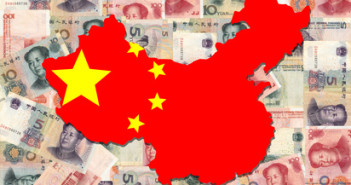Following the tone set by the DOW yesterday which fell 243 points, Asian equities fell as well although the move wasn’t as bad as the US equity market.  What helped the Asian equity markets was the release of economic news out of China that showed HSBC Flash manufacturing PMI rose from 47.9 in September to 49.1 in October.
This was the highest recorded number in three months, but it is still below the 50.0 dividing line defining expansion and contraction.  The number shows a clear direction in momentum and is evidence that the Chinese economy is bottoming out.  The “new orders†component of this number reached a six month high, which offered further evidence that a turn in the economy may be sustainable.
One of the main beneficiaries of this news is the Australian Dollar. Â Good news for China is good news for Australia. Â Add to this, good inflation news out of Australia, and now there is doubt about whether there will be further rate cuts by the RBA over the coming year. Â Australian CPI rose more than expected by 1.4% for the quarter and 2.0% for the year in the third quarter, which was better that the consensus numbers of 1.0% for the quarter and 1.6% for the year. Â Most observers now do not expect to see a rate cut in November.
The AUD has benefited from all of this, once again crossing the 1.0300 threshold on the upside.
The EUR fell after economic data was released showing EMU Services PMI fell to 46.2 in October, Manufacturing PMI fell to 45.3 as well, and the composite number dropped to 45.8, which were all below expectations.  These numbers have added fuel to the selling fire after disappointing PMI prints out of France and Germany.  German IFO-Business Climate release also fell from 101.4 in September to 100 in October.  This was less than the consensus number of 101.5.  EUR fell to a low of 1.2920, before coming back a bit into the 1.2930’s.  Support for the EUR remains at 1.2900, then 1.2885, while resistance remains at 1.2995-1.3000.
The October FOMC meeting concludes this afternoon, with most observers not expecting any surprises.  The FED Funds rate is expected to remain unchanged and there should be no adjustment on asset purchases.  The accompanying statement should have little surprise as well.  This will lead to speculation that the December meeting will be the interesting one. The Presidential election will be over and Operation Twist will have been completed. The expectations are that in December, QE3 will be expanded from $40 billion per month at present to $85 billion per month, beginning in January.  No one expects and dramatic change in the FED’s monetary stance anytime soon.
EUR has taken quite a fall in the last few days and is in a somewhat oversold status at present, which should slow and real further move lower for the time being. Â Any bounce back is probably due to position covering. Â The direction at the moment is for a test lower, but these moves have been slow going over the last few trading sessions.



